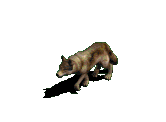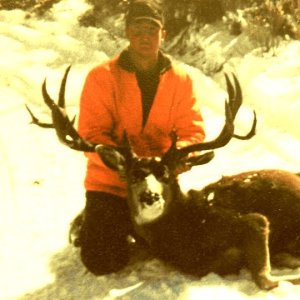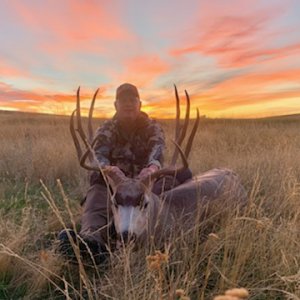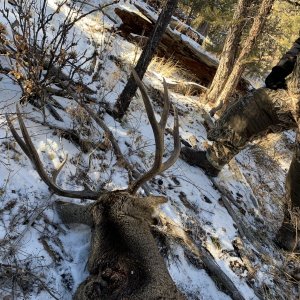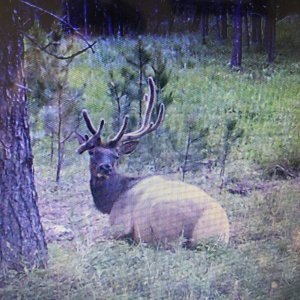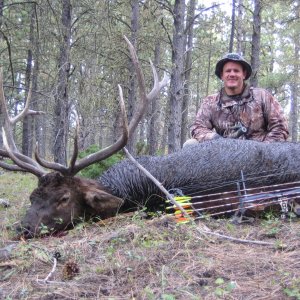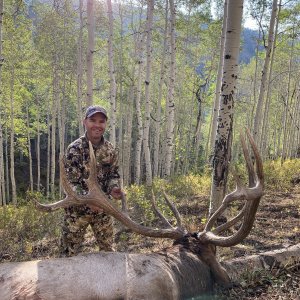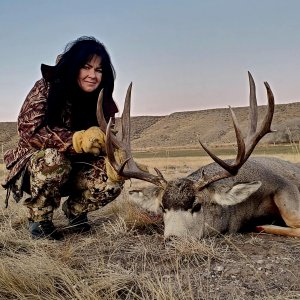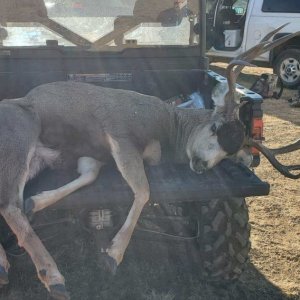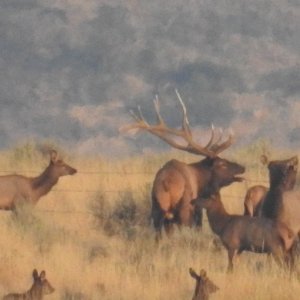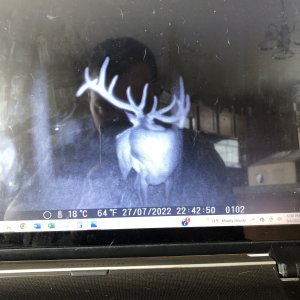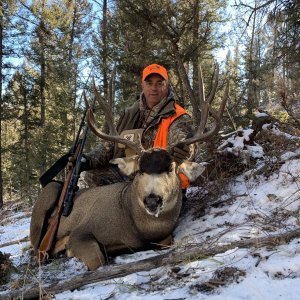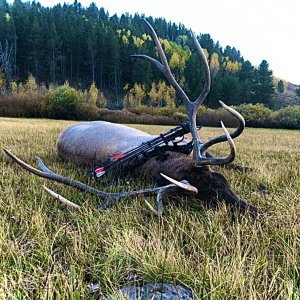HunterHarry
Long Time Member
- Messages
- 5,002
I've been a butcher for 27 years, but learned some very valuable info this year.
I first started the year by shooting a nice Blacktail with my bow.
I shot him just before dark.
Not wanting to spook him into the next county, I reluctantly waited till morning to retrieve him.
I quickly found the bloodtrail in the morning, and promptly gutted him.
He was still a bit warm on the underside.
I brought him home, skinned him and then took him to a refrigerated meat locker, where I hung his carcass.
I butchered him about 4 days later, boned him out,and froze the meat.
That buck was one of the best eating deer I've ever had.
Tender & non gamey.
A couple months later I am in the high country rifle hunting Blacktails.
I am spiked out on a big ridge overlooking a steep rough canyon.
I make a fabulous shot on a nice 4x4 buck.
I put my backpack on, cross the canyon and find my buck.
This is VERY nasty, rough country and the only way to get the buck out of this wilderness is on your back.
I take some nice photos, then skin and bone out the buck on the spot.
His muscles are still twitching as I run my knife through him.
After a gruelling hike out, I finally get home, and process the meat and freeze it.
This buck ate like shoe leather!
I mean my jaws were sore after one steak!
Both bucks were probably about the same age, both were in great shape and had LOTS of fat covering them.
Neither were anywhere close to rutting and still had their summer coats on.
These two scenarios are perfect examples of Meat Science.
Buck #1 cooled very slowly and allowed rigor mortis to set in with the meat still on the bone.
Buck #2 was chilled immediatley, and boned out before rigor mortis set in.
The muscles then contracted tightly upon themselves creating a dog ass tough piece of meat.
The first buck was allowed to rigor on the bone, where the muscles were not allowed to constrict upon themselves. The muscle fibres were kept from tightly constricting by their attachment to the skeletal structure.
Everyone strives to cool their meat real quickly, but as this example shows, it is possible to cool it TOO quickly.
I don't age my meat too long, as I hate to throw away that leathery outside covering that accumulates on a buck that hangs too long.
My findings were backedup by a Federal Meat inspector that I know with a 4 year degree in Animal Science.
I also highly recommend boning out your vennison.
Most of the gamey flavor comes from the bone marrow.
When cut on a band saw, that marrow is smeared onto every cut of meat, contaminating it with the gamey flavor.
Most meat shops process with speed in mind and don't want to take the time to prepare your meat boneless.
I also add a considerable amount of Beef fat (about 25%) to my ground vennison, it really sweetens up the meat.
I love buck burgers!
This was a valuable lesson.
Just thought I'd pass it on to you guys.
HH
I first started the year by shooting a nice Blacktail with my bow.
I shot him just before dark.
Not wanting to spook him into the next county, I reluctantly waited till morning to retrieve him.
I quickly found the bloodtrail in the morning, and promptly gutted him.
He was still a bit warm on the underside.
I brought him home, skinned him and then took him to a refrigerated meat locker, where I hung his carcass.
I butchered him about 4 days later, boned him out,and froze the meat.
That buck was one of the best eating deer I've ever had.
Tender & non gamey.
A couple months later I am in the high country rifle hunting Blacktails.
I am spiked out on a big ridge overlooking a steep rough canyon.
I make a fabulous shot on a nice 4x4 buck.
I put my backpack on, cross the canyon and find my buck.
This is VERY nasty, rough country and the only way to get the buck out of this wilderness is on your back.
I take some nice photos, then skin and bone out the buck on the spot.
His muscles are still twitching as I run my knife through him.
After a gruelling hike out, I finally get home, and process the meat and freeze it.
This buck ate like shoe leather!
I mean my jaws were sore after one steak!
Both bucks were probably about the same age, both were in great shape and had LOTS of fat covering them.
Neither were anywhere close to rutting and still had their summer coats on.
These two scenarios are perfect examples of Meat Science.
Buck #1 cooled very slowly and allowed rigor mortis to set in with the meat still on the bone.
Buck #2 was chilled immediatley, and boned out before rigor mortis set in.
The muscles then contracted tightly upon themselves creating a dog ass tough piece of meat.
The first buck was allowed to rigor on the bone, where the muscles were not allowed to constrict upon themselves. The muscle fibres were kept from tightly constricting by their attachment to the skeletal structure.
Everyone strives to cool their meat real quickly, but as this example shows, it is possible to cool it TOO quickly.
I don't age my meat too long, as I hate to throw away that leathery outside covering that accumulates on a buck that hangs too long.
My findings were backedup by a Federal Meat inspector that I know with a 4 year degree in Animal Science.
I also highly recommend boning out your vennison.
Most of the gamey flavor comes from the bone marrow.
When cut on a band saw, that marrow is smeared onto every cut of meat, contaminating it with the gamey flavor.
Most meat shops process with speed in mind and don't want to take the time to prepare your meat boneless.
I also add a considerable amount of Beef fat (about 25%) to my ground vennison, it really sweetens up the meat.
I love buck burgers!
This was a valuable lesson.
Just thought I'd pass it on to you guys.
HH

